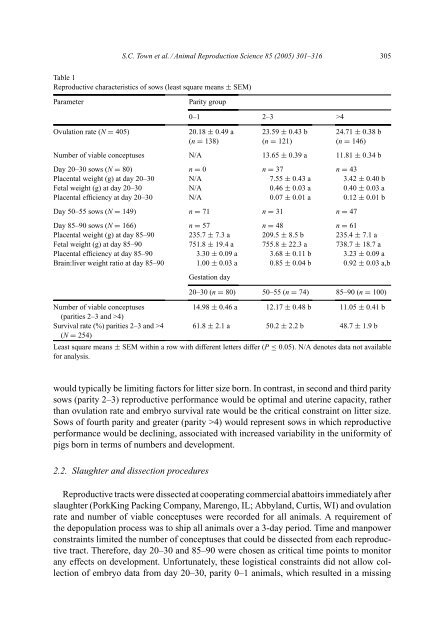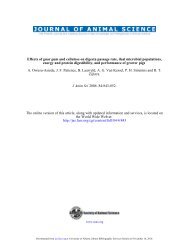Embryonic and fetal development in a commercial dam-line genotype
Embryonic and fetal development in a commercial dam-line genotype
Embryonic and fetal development in a commercial dam-line genotype
Create successful ePaper yourself
Turn your PDF publications into a flip-book with our unique Google optimized e-Paper software.
S.C. Town et al. / Animal Reproduction Science 85 (2005) 301–316 305Table 1Reproductive characteristics of sows (least square means ± SEM)ParameterParity groupOvulation rate (N = 405)0–1 2–3 >420.18 ± 0.49 a(n = 138)23.59 ± 0.43 b(n = 121)24.71 ± 0.38 b(n = 146)Number of viable conceptuses N/A 13.65 ± 0.39 a 11.81 ± 0.34 bDay 20–30 sows (N = 80) n = 0 n = 37 n = 43Placental weight (g) at day 20–30 N/A 7.55 ± 0.43 a 3.42 ± 0.40 bFetal weight (g) at day 20–30 N/A 0.46 ± 0.03 a 0.40 ± 0.03 aPlacental efficiency at day 20–30 N/A 0.07 ± 0.01 a 0.12 ± 0.01 bDay 50–55 sows (N = 149) n = 71 n = 31 n = 47Day 85–90 sows (N = 166) n = 57 n = 48 n = 61Placental weight (g) at day 85–90 235.7 ± 7.3 a 209.5 ± 8.5 b 235.4 ± 7.1 aFetal weight (g) at day 85–90 751.8 ± 19.4 a 755.8 ± 22.3 a 738.7 ± 18.7 aPlacental efficiency at day 85–90 3.30 ± 0.09 a 3.68 ± 0.11 b 3.23 ± 0.09 aBra<strong>in</strong>:liver weight ratio at day 85–90 1.00 ± 0.03 a 0.85 ± 0.04 b 0.92 ± 0.03 a,bGestation dayNumber of viable conceptuses(parities 2–3 <strong>and</strong> >4)Survival rate (%) parities 2–3 <strong>and</strong> >4(N = 254)20–30 (n = 80) 50–55 (n = 74) 85–90 (n = 100)14.98 ± 0.46 a 12.17 ± 0.48 b 11.05 ± 0.41 b61.8 ± 2.1 a 50.2 ± 2.2 b 48.7 ± 1.9 bLeast square means ± SEM with<strong>in</strong> a row with different letters differ (P ≤ 0.05). N/A denotes data not availablefor analysis.would typically be limit<strong>in</strong>g factors for litter size born. In contrast, <strong>in</strong> second <strong>and</strong> third paritysows (parity 2–3) reproductive performance would be optimal <strong>and</strong> uter<strong>in</strong>e capacity, ratherthan ovulation rate <strong>and</strong> embryo survival rate would be the critical constra<strong>in</strong>t on litter size.Sows of fourth parity <strong>and</strong> greater (parity >4) would represent sows <strong>in</strong> which reproductiveperformance would be decl<strong>in</strong><strong>in</strong>g, associated with <strong>in</strong>creased variability <strong>in</strong> the uniformity ofpigs born <strong>in</strong> terms of numbers <strong>and</strong> <strong>development</strong>.2.2. Slaughter <strong>and</strong> dissection proceduresReproductive tracts were dissected at cooperat<strong>in</strong>g <strong>commercial</strong> abattoirs immediately afterslaughter (PorkK<strong>in</strong>g Pack<strong>in</strong>g Company, Marengo, IL; Abbyl<strong>and</strong>, Curtis, WI) <strong>and</strong> ovulationrate <strong>and</strong> number of viable conceptuses were recorded for all animals. A requirement ofthe depopulation process was to ship all animals over a 3-day period. Time <strong>and</strong> manpowerconstra<strong>in</strong>ts limited the number of conceptuses that could be dissected from each reproductivetract. Therefore, day 20–30 <strong>and</strong> 85–90 were chosen as critical time po<strong>in</strong>ts to monitorany effects on <strong>development</strong>. Unfortunately, these logistical constra<strong>in</strong>ts did not allow collectionof embryo data from day 20–30, parity 0–1 animals, which resulted <strong>in</strong> a miss<strong>in</strong>g




